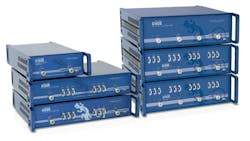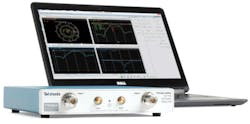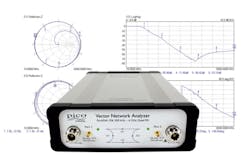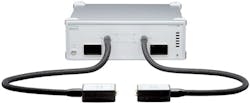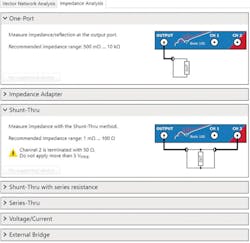IoT, 5G, connected cars drive VNA applications
Once considered arcane laboratory instruments operated by experts, vector network analyzers are going mainstream. While expensive, high-performance instruments with frequency ranges beyond 1 THz have a key role to play, lower cost, easier-to-use alternatives are placing VNA technology in the hands—literally in the case of the more portable versions—of a variety of engineers who may use the instruments only sporadically. Today’s VNAs are available in a variety of form factors and architectures—including handheld USB versions, PXI modules, and benchtop configurations.
Trending toward 5G
Alex Goloschokin, founder and chief revenue officer of Copper Mountain Technologies, said he expects in 2018 to see a trend toward multiport VNAs as well as VNAs that can serve 28- and 40-GHz applications, including 5G. In addition, he sees a trend toward compact VNAs that allow engineers to take the VNA to the DUT—not the other way around. Finally, he said he expects low-cost portable VNAs to increasingly find use in medical, agricultural, automotive-radar, IoT, and antenna-measurement applications.
Stanley Oda, ShockLine product manager at Anritsu, identified some similar trends. “Design and development of components and devices used for 5G applications creates an opportunity for VNAs, which have inherent advantages in high-frequency applications,” he said. “For this reason, there will be more demand for 28-GHz, 39-GHz, and 60-GHz VNAs in 2018, as 5G-related devices will gain traction in the marketplace.”
Oda continued, “One growing application where VNAs play a vital role is in connected-car designs. Driver-assisted radar systems, which operate in the 76- to 81-GHz frequency range, and infotainment systems with high data-transmission rates are gaining in popularity, and driving demand for VNAs to measure antennas, cables, and other RF and microwave devices. Along similar lines, high-speed network systems operating at 100G/400G present an opportunity for VNAs, which can be used to conduct O/E and E/O measurements.”
Dylan Stinson, product manager for RF products at Tektronix, said the company sees the VNA market as healthy and expects it to grow steadily over the next 10 years. “Much of this is due to existing market drivers such as the desire for wireless everywhere, continued demand for greater bandwidth, increased energy efficiency, and the push for video everywhere,” he said. “It’s estimated that 50 billion wireless devices will be connected to the Internet by 2020.” Consequently, he added, engineers must have more and more RF and microwave test knowledge and expertise as well as access to compact instruments that can help companies reduce cost of test.
Stinson also said that while traditional VNA applications—such as cable, filter, and amplifier test and impedance matching—dominate the market, “…we also see more importance being applied to applications such as Ethernet compliance and EMI precompliance testing, where precise and accurate S-parameters are necessary for characterizing test fixtures, testing for cross-talk and loss, and ensuring that designs pass compliance for their specified standard.”
According to Mark Ashcroft, RF business-development manager at Pico Technology, “For microwave or gigabit/s data engineers, technicians, teachers, or students, the vector network analyzer is as vital as the oscilloscope or handheld meter at lower frequencies. However, we don’t yet see one on every bench or in every tool bag.” Excessive cost, and to some extent, fragility are the main hurdles, he said, adding, “With the recent and projected growth of gigabit/s data paths, now in nearly every home, in every car, and on every person, the demand for low-cost, robust, and fast vector network analysis is growing inexorably.”
Charles Hymowitz, vice president of marketing and sales at Picotest, cited another application area: power integrity. Engineers must measure components such as capacitors and beads to obtain data for use in simulation, he said, adding, “Without good-quality measurements, it is difficult—if not impossible—to make models with the required fidelity that is necessary to design, predict, and optimize a decoupling scheme and power-distribution network impedance.”
USB puts lab in your hand
Copper Mountain offers a line of VNAs that, Goloschokin said, “…gives the user lab-grade performance in a handheld device” that connects to a processing module via USB. “We are unique because our analyzers provide metrology-grade measurements in a smaller form factor and lower price point,” he added.
A recent addition is the R180 1-port USB VNA (a reflectometer that can serve as a cable and antenna analyzer), which features a frequency range from 1 MHz to 18 GHz. The R180, Goloschokin said, “…is the first 18 GHz 1-port VNA that can connect directly to the DUT, improving measurement accuracy by eliminating the practical limitation of RF cables. The R180 can be controlled and powered through a USB-C port or through an external 5-VDC power supply. The unit delivers high-accuracy results in a wide variety of measurement formats including time-domain measurement.”
The company within the past year has also expanded its Cobalt VNA Series (Figure 1) from three to 12 models, which offer industry-leading dynamic range and sweep speed, Goloschokin said. The new products include 2- and 4-port analyzers and have options for direct receiver access and frequency extension. Cobalt Series VNAs come in two frequency ranges: 100 kHz to 9 GHz and 100 kHz to 20 GHz.
Courtesy of Copper Mountain Technologies
Tektronix has recently entered the USB VNA market with its TTR500 Series (Figure 2), which adds to the company’s portfolio of USB-based RF instruments. The TTR500 offers a 122-dB dynamic range and a 6-GHz frequency range; it also comes with the company’s VectorVu-PC analysis software.
Courtesy of Tektronix
“With its innovative architecture and disaggregated design, the TTR500 rivals the leading benchtop competition, at a 40% lower price,” Stinson said. “While one-seventh the size and weight, it delivers benchtop-quality RF performance on key parameters like dynamic range and includes a built-in bias tee you may have paid extra for in the past. This new architecture also reduces component count and complexity for more reliability compared to benchtop VNAs.”
Pico Technology entered the VNA market last June with the PicoVNA 106 USB-controlled instrument. According to the company’s Ashcroft, “The PicoVNA 106 is a full-function bidirectional vector network analyzer covering 300 kHz to 6 GHz able to compete on an equal footing with all available and legacy VNAs in this frequency range.”
The instrument boasts a full-function, minimal-error, “Quad RX” four-receiver architecture that supports both 8- and 12-term calibration without the uncorrectable switching errors, delays, and unreliability of traditional three-receiver designs. The instrument (Figure 3) supports convenient calibration methods such as “enhanced isolation correction” and “unknown thru,” the company reported, adding that the instrument is suitable for classrooms, small businesses, and even amateur workshops, yet is able to meet the needs of the microwave laboratory and expert. The vendor includes bias tees for the convenient injection of a bias or test stimulus.
Courtesy of Pico Technology
The PicoVNA 106 has dynamic range of up to 118 dB at 10 Hz and 0.005-dB RMS trace noise at its maximum bandwidth of 140 kHz. It comes with Microsoft Windows software to support a range of plot formats for scalar and vector view of dual- or single-port parameters. Data can be saved or exported in various graphic and tabular formats including Touchstone. The software includes, at no additional cost, inverse Fourier transformation to the time domain, adding convenient distance-to-fault capability and pulse-response determination.
Ashcroft said the instrument, including time-domain display capability and bias tees, costs $5,995. “We can only conclude, I think, that the PicoVNA 106 will initiate a trend toward rapid cost reduction and proliferation,” he said.
Anritsu’s ShockLine VNAs offer USB or LAN connectivity. Oda said the company has recently upgraded the ShockLine family (Figure 4) with new software. “The enhancements include usability improvements like a drag-and-drop marker data display that enables users to place the marker data readout anywhere on the trace display and trace thickness adjustment for better graphic visibility,” he said. “Functionality was improved with the addition of hybrid calibration for combining multiple calibration files into one, as well as upgraded 5-band LRL menus for greater LRL calibration frequency coverage. An improved simulator makes it easier to simulate any of the ShockLine VNAs.”
Courtesy of Anritsu
Benchtop VNAs
Anritsu has also added new functionality to its VectorStar benchtop VNAs, according to Steve Reyes, VNA product manager. “A Universal Fixture Extraction (UFX) option expands on-wafer and fixture calibration choices, even when a full set of calibration standards is not available,” he said. “VectorStar VNAs configured with UFX enhance modeling accuracy through improved test fixture de-embedding, which improves first-time yields. The UFX option also has advanced de-embedding tools that allow engineers to incrementally add calibration standards and characteristic data as they become available, for improved fixture-extraction accuracy.”
He added that the UFX option also includes a sequential peeling feature to aid in analyzing isolated defects within the test fixture. “This function provides more detailed information about the fixture to more easily improve the test fixture design,” he said.
Reyes continued, “Other recent enhancements to the VectorStar family include an integrated calibration capability that significantly reduces the complexity of a coaxial calibration by eliminating the need to merge separate OSL and SSS calibrations over the entire 70-GHz to 110/145-GHz frequency range of the ME7838 Series broadband VNAs. A new Equation Editor feature allows engineers to develop a comprehensive set of operations between trace data sets, as well as S-parameter sets.” The main dialog consists of more than 30 functions and input variables, as well as scalar entry along with editing tools to simplify VNA operation.
Other VNAs in the news include the R&S ZNL (Figure 5) from Rohde & Schwarz. Introduced in October, the ZNL features a 10.1” WXGA touchscreen, providing a good overview of measurement details. Weighing 6 kg to 8 kg and featuring a carrying handle and optional battery, the instrument is portable and can be used wherever needed.
Courtesy of Rohde & Schwarz
With frequency ranges from 5 kHz to 3 GHz or 6 GHz, the R&S ZNL is suited for various RF component measurement applications in industrial electronics and wireless communications. The R&S ZNL offers a dynamic range of up to 130 dB (typ.) and an output power range from -40 dBm to +3 dBm (typ.). The measurement speed is high—for instance, 16.7 ms (401 points, 100-kHz IF bandwidth, 200-MHz span, 2-port calibration). Standard features include embedding/de-embedding, fixture compensation, time-domain measurements, and support of automatic calibration units.
The R&S ZNL can be equipped with full spectrum-analyzer hardware, and when combined with an R&S NRP power sensor, it turns into a power meter. In this way, the company said the R&S ZNL becomes a true 3-in-1 “allrounder” that can handle continually changing measurement tasks, helping research and service labs to reduce investment costs.
Keysight offers a variety of vector network analyzers, including portable, bench, and PXI models. In this last category are PXI models with six frequency ranges up to 26.5 GHz. Each offers full two-port S-parameter measurements in a single PXI slot; engineers can cascade multiple modules for true multiport applications. And for portable applications, the company offers its FieldFox family, which provides a choice of 22 combination and spectrum analyzer models with frequency coverage from DC to 50 GHz; users can configure combo models to include a spectrum analyzer or VNA.
The company’s benchtop models include the top-of-the-line PNA-X/PNA/PNA-L, with frequency ranges to 1.1 THz. An economical alternative is the ENA family. The E5071C ENA 2- or 4-port, 50-Ω, S-parameter test set, for example, offers frequency ranges from 9 kHz to 20 GHz. It offers a dynamic range of 130 dB, 8-ms measurement times, and temperature stability of 0.005 dB/°C. A Keysight spokesperson said the E5071C ENA will be exhibited at DesignCon in conjunction with the company’s Physical Layer Test System 2017 to demonstrate manufacturing test of high-speed interconnects including cables, backplanes, PCBs, and connectors. (For more on DesignCon, January 31-February 1 in Santa Clara)
Making VNAs easy to use
Speaking at EDI CON USA in Boston in September, Faride Akretch, segment marketing manager at Rohde & Schwarz, acknowledged that VNAs have a reputation that they are hard to use. Setup wizards and undo/redo functions can go a long way to ensure that engineers never need to be scared to mess up a setting, he said.
Goloschokin at Copper Mountain cited the importance of the user interface. “We are working on developing a new generation of the user interface that will be more user-friendly and self-explanatory with wide use of different wizards to guide users through the test procedure,” he said. “We are constantly working on making our automatic calibration modules more accessible to users so that complex calibration procedures could be substituted with easy but metrologically sound automatic calibration.” In addition, he said, the company is working on creating application-specific software that will limit users’ exposure to just the applications that are relevant to them.
Oda at Anritsu also commented on the user interface. “As VNAs become an essential part of a test bench in more applications, software enhancements must consider the range of users who will use the instruments,” he said. “Anritsu considers ease of use when developing features and making software changes to achieve the best balance between providing ultimate flexibility to experienced users and ensuring new users can leverage the capability of our instruments through preconfigured setups and measurements.”
Stinson at Tektronix commented, “The fact of the matter is, most people don’t use a VNA every day. For instance, some may think VNA measurements are shrouded in mystery; you may have been told to let the trained techs make your measurements for you; or you’re in school, but you can’t even get close to the VNA in order to learn to use it because only the grad students typically get to use the lab VNA. There are a lot of reasons you may not have wanted or been able to use a VNA in the past as part of your typical test regimen. This means that it’s more important than ever for VNAs to be simple and easy to learn, especially for the most widely used tasks.”
He continued, “Yet, for experienced VNA users, where moderate-to-advanced measurement tasks are a way of life, a common and industry-standard user interface is most important because it ensures that they can easily transition to using the new equipment with as little relearning as possible.” As for the TTR500, he said it’s optimized for touch and mouse control and is designed to deliver a user interface that’s both simple and easy-to-learn for novice users as well as familiar and recognizable to experienced VNA users.
Low-frequency VNA
The VNAs mentioned so far operate at gigahertz-and-above frequencies. A low-frequency, lower-cost alternative is the OMICRON Lab Bode 100, available from Picotest in the United States. “With the multifunctional Bode 100 you get an exact picture of your electronic circuits and components in a frequency range from 1 Hz to 50 MHz,” said Picotest’s Hymowitz. “The Bode 100 is not only a state-of-the-art vector network analyzer—it also works as a frequency response analyzer, impedance meter, gain and phase meter, and sine-wave generator.”
He emphasized that the Bode 100 is a true VNA, not just an FRA, so it handles S-parameters, making it suitable for supporting power-integrity applications including component and circuit-impedance testing. He said, “We have created a new semi-floating differential amplifier, the J2113A, to support low-high frequency component testing. We have also created a decoupling-board test kit with accurate mounts (software and hardware) that support high-fidelity testing. In the coming year, Picotest will produce a cost-effective inductor bias tester capable of reaching over 125 A.” He also emphasized the instrument’s price/performance ratio: “It is low cost—list price is $5,490—yet it has all the high-end features and performance of analyzers costing three to eight times more.”
Hymowitz also commented on ease of use. “Various tests are supported by software wizards that derive all instrument settings and guide the physical test setup with simple-to-implement diagrams,” he said. “The new Bode 100 Software Suite features menu-driven measurement setups. With just a few clicks, you can select a measurement and begin testing. The software even guides you with information to make the best test, based on the test and the impedance being measured” (Figure 6).
Courtesy of Picotest
“You can save multiple waveforms to memory, allowing easy comparison of varied test conditions,” he continued. “Calibration is streamlined, and the user interface keeps you informed of the calibration validity.”
He concluded, “Those not familiar with currently available test equipment, such as the Bode 100, are missing a completely different and improved user experience. These negative past experiences are not valid anymore. The software-driven analyzers of today are extremely easy to use. They are a world apart from the arcane HP 3577B-type interfaces.”
If, however, you like arcane interfaces, you can buy a refurbished HP 3577B from Test Equipment Depot.
For more information:

